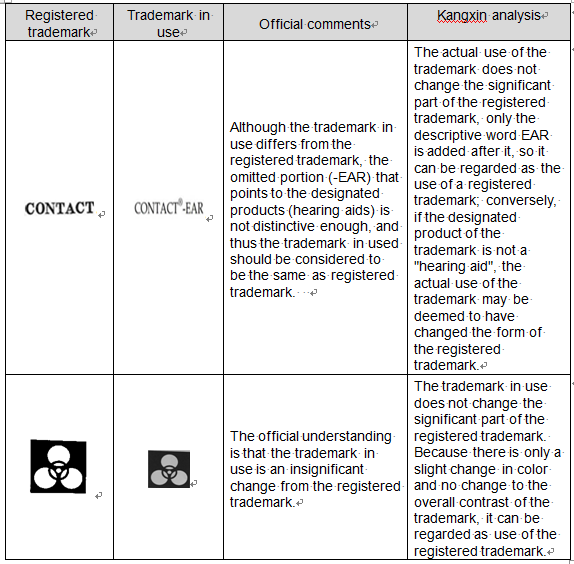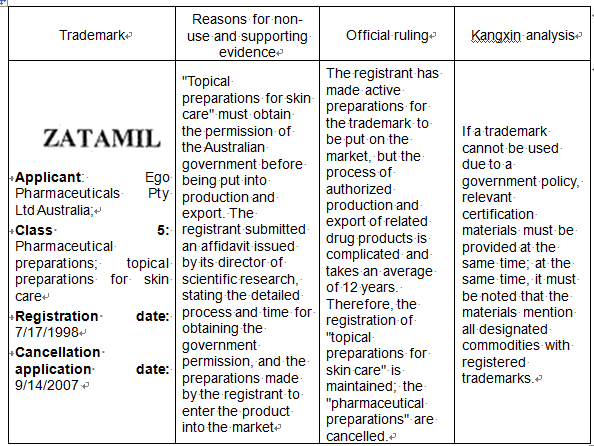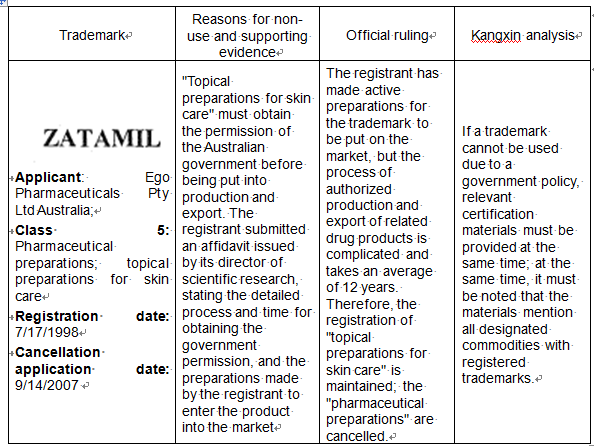
Businesses entering a new market may be concerned with many issues, and one of them should be their valid registration and use of trademarks for the goods or services to be offered under that mark. With China’s steady rise on the global stage, more Chinese businesses are entering the international market and encountering IP protection issues, as are businesses everywhere, whether in China or abroad. Below are some considerations of local regulations brand owners should be aware of when expanding and protecting their business abroad.
Trademarks regulations outside of China are diverse, but can be generally divided into three types:
- active use, which, as the name implies, indicates the intent to use the registered trademarks in commercial activities;
- passive use, that is, use to maintain the validity of the trademark registration, done usually to prevent non-use cancellation or to provide evidence of use;
- and unused, that is, the trademark is not used locally.
Regardless of the type of use, there are many matters in the use of trademarks that require special attention from the trademark registrant.
Trademark Regulations
According to Article 49 of China’s Trademark Law, where a trademark registrant changes the registered trademark, registrant’s name, address or other registration matters by himself in the process of using a registered trademark, the local administration for industry and commerce shall order the time limit for correction; if it is not corrected in the allotted time, the trademark office shall cancel its registered trademark.
The standardized use of registered trademarks is mainly divided into the following:
· The subject of trademark use must be legal;
· The trademark use must be legal;
· The name and scope of the goods or services that use the trademark must be legal;
· If the subject of trademark rights has changed, the trademark transfer or name change will not be handled;
· Changing the text, graphics, colors or combinations of the registered trademark by oneself; adding the registered trademark mark when the registered trademark is used beyond the scope of the approved goods/services, etc., all are considered to be an irregular use of the trademark.
Although the above requirements are stipulated by China's Trademark Law, they are also applicable to other countries and regions.
First, the legal use of trademark subject, that is, the trademark must be used by the trademark registrant or licensee. Any unauthorized malicious use is not in compliance with the law.
Secondly, the trademark used must be legal, that is, the trademark actually used must be consistent with the trademark stated in the registration certificate, and no changes can be made to prevent trademark infringement or in the case of a trademark invalidation the rights owner will not be able to provide evidence of the use of the registered trademark, as it will be considered invalid. However, in actual market use, since the use of trademarks in different media needs to match different trademark forms to better achieve the purpose of product promotion, it is inevitable to make slight adjustments to registered trademarks. Under normal circumstances, as long as the significant parts of the trademark remain unchanged during the use of overseas trademarks, there is usually no high risk, but it is necessary to ensure that 1) the text and graphic elements of the trademark have not changed; 2) the entire trademark conforms to the contrasting elements of the registered trademark; 3) If the color of the trademark needs to be changed, the color itself cannot be used as the main distinguishing part of the trademark, and the color itself must not exist to improve the distinctiveness of the trademark. The case of changing the registered trademark is as follows:

Third, the goods/services used by the trademark must be consistent with the scope of protection listed in the registration certificate. However, since the Nice Classification cannot exhaust all goods and services, the actual use of similar items usually has a lower risk of infringement.
Finally, the trademark registration mark marks a registered trademark, and can only be used when the registered trademark is used in its registered goods. If the text, graphics, color or combination of the registered trademark have been changed by the rights owner, or the trademark is being used beyond its the scope of registration, the use of will be considered to be an act of fraudulent use of a registered trademark; however, it is recommended to use the TM mark after changing the trademark, which not only indicates the source of the product, but also reminds the user that the mark belongs to a rights owner rather than being a general/descriptive word, and can be an effective warning against malicious cybersquatters or other bad faith actors.
Trademark use form
Trademark use refers to the commercial use of trademarks, including the use of trademarks on goods, goods packaging or containers, and goods transaction documents, or the use of trademarks in advertising, exhibitions and other commercial activities to identify the source of goods.
The use form is as follows:
· Adopt direct attachment, engraving, branding or weaving methods to attach the trademark to the product, product packaging, container, label, or use it on the attached label, product manual, introduction manual, price list;
· Trademarks are used in transaction documents related to commodity sales, including commodity sales contracts, invoices, bills, receipts, commodity import and export inspection and quarantine certificates, and customs declaration documents;
· Trademarks are used on radio, television and other media, or published in publicly issued publications, and advertisements for trademarks or goods using trademarks on billboards, postal advertisements or other advertising methods;
· The use of the trademark in exhibitions and expositions, including the printed materials and other materials that use the trademark provided at the exhibition and exposition;
· Other forms of trademark use that comply with the law.
Please note that in addition to the above-mentioned trademark use forms, some countries require a use statement have special requirements for use evidence, such as:
In the U.S., a media report cannot be regarded as the applicant’s active use because it belongs to a third-party report. Therefore, it cannot indicate the applicant’s true intention to use it, so it cannot be used as evidence of use; pictures of fairs and promotional materials can be regarded as the effective use evidence of the product trademark only when it clearly reflects the product image/product packaging image with the trademark.
Another typical case is that in the Philippines, the name and address of the local store must be stated when providing a statement of use to indicate the real trademark use.
Only on the premise of standardized use of trademarks and trademark use forms can the normal use of trademarks and the validity of trademarks be maintained. So if the trademark is not in use, how can a rights owner maintain the trademark registration?
Defense strategy for trademarks not in use
The above-mentioned Chinese trademark law stipulates the defense of non-use in non-use revocation. In addition to non-use revocation cases overseas, some countries require periodic provision of use statements. Therefore, we use the two dimensions of non-use declaration and non-use revocation to introduce a non-use trademark strategy.
First, countries such as the United States, Cambodia, the Philippines, Mexico and other popular jurisdictions require regular submission of the use statement and/or use evidence of the registered trademark; if the registrant fails to submit it on time, the trademark will be invalidated, but there are also some countries, including Haiti and Belize, that allow non-use declaration to be submitted. According to Haitian law, evidence of use/use affidavit shall be provided within three months after a trademark has been registered for 5 years; then an application for renewal shall be submitted after 10 years, and evidence of use shall be provided after 15 years, and so on. If the trademark is not used after registration, you can submit a "non-use statement" to the official, providing a reasonable explanation, such as not finding a local distributor, etc.; According to Belize law, when a trademark is renewed, it is necessary to state whether the trademark is used or not. If it is not used, the reason for non-use must be stated. If the reason for the unused trademark is not accepted by the government, the official is likely to refuse the renewal. The most common non-use reasoning used is that "the customer's trademark cannot enter the market due to market reasons, but the customer has been actively preparing for the use of the trademark".
Second, in non-use cancellation, according to Article 49 of China's Trademark Law, (1) force majeure; (2) government policy restrictions; (3) bankruptcy liquidation; (4) trademark owners have true use of the trademark and have undertaken necessary preparations for actual use, but the trademark has not been actually used due to other objective reasons; (5) Other legitimate reasons not attributable to the trademark registrant. According to Article 26 of Provisions of the Supreme People's Court on Several Issues Concerning the Trial of Administrative Cases for the Authorization and Confirmation of Trademarks, the trademark owner who has the intention to use the trademark in real terms and has undertaken necessary preparations for actual use, but has not actually used the registered trademark due to other objective reasons, may be determined to have justifiable reasons for non-use.
Most other jurisdictions also offer the possibility of defense of non-use, such as:
Article 119-3 of the Korean Trademark Law: Article 119-1-3 shall not apply if the owner of a registered mark has a justifiable reason for not using the registered mark;
Article 130 of the Mexican Industrial Property Law: If for three consecutive years a mark is not used for the products or services for which it was registered, there shall be grounds for the lapse of the registration thereof, except where the owner or registered licensee has used it during the three consecutive years immediately prior to the filing of the request for the administrative declaration of lapse, or where a situation has arisen that is beyond the control of the owner of the mark which constitutes an obstacle to the use thereof, such as the restriction of imports or other government requirements applicable to the goods or services to which the mark is applied.
Common reasons for non-use defense include: government restrictive policies, such as import restrictions, embargo regulations, and government restrictive policies on related products; products which are still in clinical trials that cannot be put on the market or have not yet obtained permission from the local drug administration – this reason is common in trademarks in the pharmaceutical industry; force majeure; other reasons that are not under the control of the trademark registrant, etc. However, no matter what kind of non-use defense, the trademark owner needs to prove its true intention to use and the necessary preparations for actual use. The following cases of non-use serve as examples:
Case 1 – EU trademark non-use cancellation

Case 2: Spain trademark non-use cancellation

Through the above cases, we can see that in the case of unused trademarks, trademark registrants still need to actively prepare for market launch, and need to pay attention to the government restriction policies for all designated goods or other objective factors that lead to the non-use of trademarks.
Supplementary registration
The mandatory requirements for the declaration of trademark use in foreign jurisdictions, the specific time limit for non-use cancellation, etc. vary by country and region. If the trademark is not used and no persuasive certification materials are available, how can we protect our trademark rights? Supplementary registration is required at this time.
Supplementary registration is not as simple as re-submitting a registration application. Most countries do not allow two identical trademarks under the same applicant's name. The main reasons are 1) to avoid waste of administrative resources; 2) to control malicious preemptive trademark registration.
Therefore, rights owners should pay attention to supplementary registration: 1) Regular supplements are made according to the time limit of different countries. For example in Italy, non-use cancellation can be applied for only 5 years after the trademark registration is approved, which requires the applicant to perform supplementary registration when the registration date is set to expire after 5 years;; 2) When supplementing registration, pay attention to making slight changes to the trademarks submitted, such as font size; or adding/removing the goods/services applied for during registration.
It can be seen from this that after a trademark is approved for registration, it is not the end of a trademark’s journey – trademark registrants still need to pay attention to the standardized use of trademarks and the collection and retention of evidence of use; material collection of reasons of non-use, advance understanding of local relevant policies, etc.;
Maintaining a registered trademark can be a time-consuming and complicated process. Using online tools to maintain a trademark portfolio is becoming a go-to solution for trademark professionals. One such tool is the Kangxin IP Platform. The platform covers trademark legal services in more than 190 jurisdictions around the world. Functions such as trademark search, registration, change, transfer, renewal, monitoring, objection, withdrawal, statistical analysis, trademark map are all available and can provide you with a one-stop global intellectual property intelligent solution.
Currently, the trademark search function is offered in 39 jurisdictions, offering such information as status of application, applicants name, address, and the similarity to the searched mark. In addition to searching for trademarks in Chinese, English, Japanese and Korean, the system also supports searching by image, which can be completed in seconds thanks to a robust AI algorithm developed in-house.
Renewal and monitoring services can be an indispensable tool in maintaining your marks in major jurisdictions – deadline reminders, automated regular monitoring results and more are all part of the service included on Kangxin IP Platform. Register at eservice.kangxin.com to simplify the management of your trademarks globally.


Follow us






